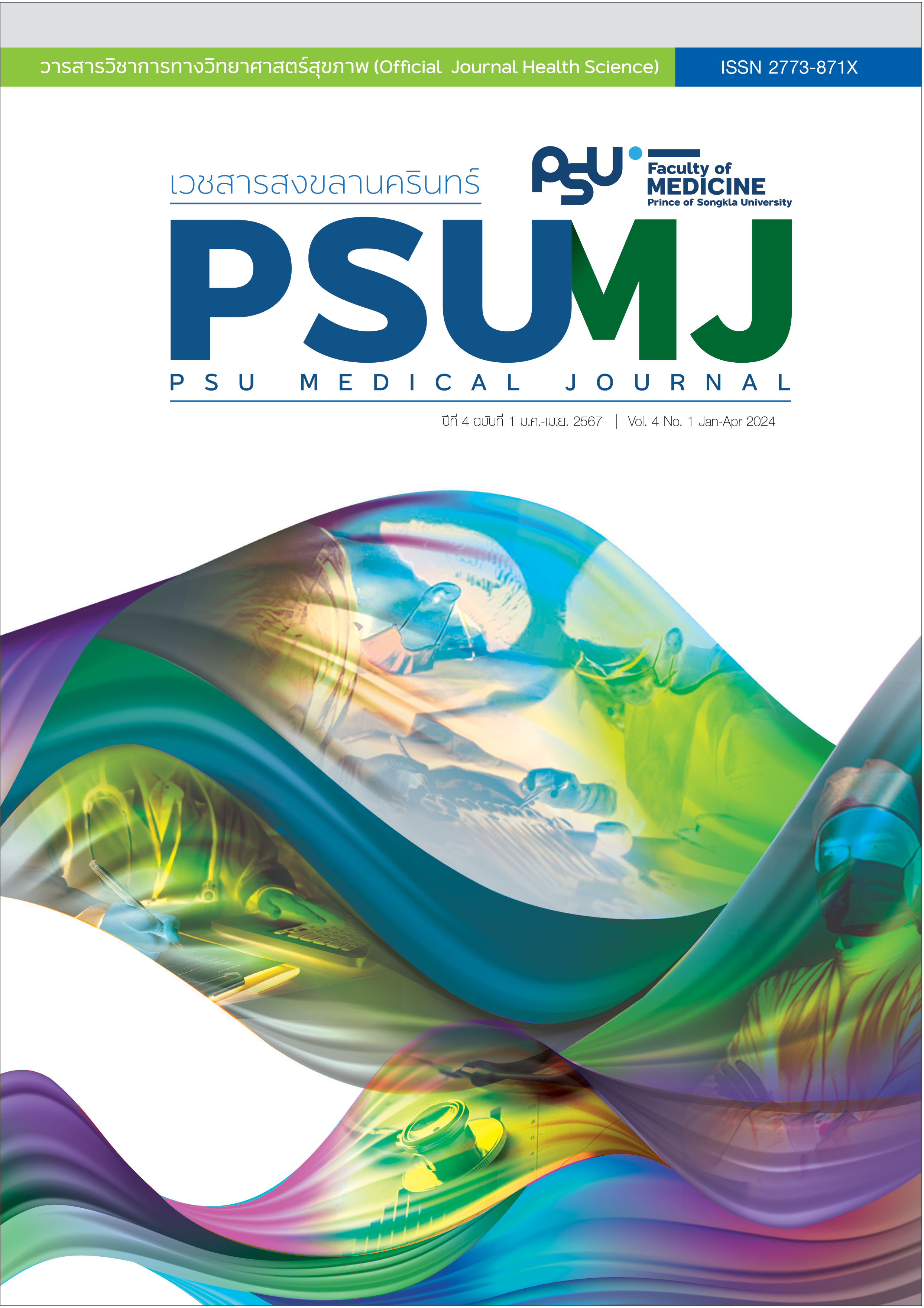Hard-to-Heal Wounds
DOI:
https://doi.org/10.31584/psumj.2024265285Keywords:
chronic wound, hard-to-heal wound, TIMERS principleAbstract
A hard-to-heal wound or chronic wound is a wound that fails to heal in an expected time due to disruption of the normal healing process. Commonly encountered chronic wounds are those occurring in patients with diabetes, long-standing pressure injuries, and venous diseases. If not treated properly, a chronic wound might be complicated with infection, threatening limb loss, and serious psychological impacts. This review addresses the concepts of chronic wound management, emphasizing the TIMERS principle. Care for specific types of wounds and modern dressing materials used in chronic wound care are also discussed.
References
Robson MC, Barbul A. Guidelines for the best care of chronic wounds. Wound Repair Regen 2006;14:647–8.
Werdin F, Tenenhaus M, Rennekampff HO. Chronic wound care. Lancet 2008;372:1860-2.
Leaper DJ, Durani P. Topical antimicrobial therapy of chronic wounds healing by secondary intention using iodine products. Int Wound J 2008;5:361-8.
Sharma RK, John JR. Role of stem cells in the management of chronic wounds. Indian J Plast Surg 2012;45:237-43.
Atkin L, Bućko Z, Montero EC, Cutting K, Moffatt C, Probst A, et al. Implementing TIMERS: the race against hard-to-heal wounds. J Wound Care 2019;28:S8-11.
Mustoe TA, O’Shaughnessy K, Kloeters O. Chronic wound pathogenesis and current treatment strategies: a unifying hypothesis. Plast Reconstr Surg 2006;117:S35-41.
Ayello EA, Dowsett C, Schultz GS, Sibbald RG, Falanga V, Harding K, et al. TIME heals all wounds. Nursing 2004;34:36-41.
Loots MA, Lamme EN, Zeegelaar J, Mekkes JR, Bos JD, Middelkoop E. Differences in cellular infiltrate and extracellular matrix of chronic diabetic and venous ulcers versus acute wounds. J Invest Dermatol 1998;111:850–7.
Herrick S, Ashcroft G, Ireland G, Horan M, McCollum C, Feguson M. Up-regulation of elastase in acute wounds of healthy aged humans and chronic venous leg ulcers are associated with matrix degradation. Lab Invest 1997;77:281–8
Rogers AA, Burnett S, Lindholm C, Bjellerup M, Christensen OB, Zederfeldt B, et al. Expression of tissue type and urokinase-type plasminogen activator activities in chronic venous leg ulcers. Vasa 1999;28:101–5.
Malone M, Bjarnsholt T, McBain AJ, James GA, Stoodley P, Leaper D, et al. The prevalence of biofilms in chronic wounds: a systematic review and meta-analysis of published data. J Wound Care 2017;26:20–5.
Jull AB, Arroll B, Parag V, Waters J. Pentoxifylline for treating venous ulcers. Cochrane Database Syst Rev 2012;12:CD001733.
Fleck CA. Differentiating MMPs, biofilm, endotoxins, exotoxins, and cytokines. Adv Skin Wound Care 2006;19:77–81.
Schultz GS, Sibbald RG, Falanga V, Ayello EA, Dowsett C, Harding K, et al. Wound bed preparation: a systematic approach to wound management. Wound Repair Regen 2003;11:S1–28.
Wilcox JR, Carter MJ, Covington S. Frequency of debridements and time to heal: a retrospective cohort study of 312 744 wounds. JAMA Dermatol 2013;149:1050–8.
Winter GD. Formation of the scab and the rate of epithelization of superficial wounds in the skin of the young domestic pig. Nature 1962;193:293-4.
Sood A, Granick MS, Tomaselli NL. Wound Dressings and Comparative Effectiveness Data. Adv Wound Care (New Rochelle) 2014;3:511-29.
Enoch S, Grey JE, Harding KG. ABC of wound healing. Non-surgical and drug treatments. BMJ 2006;332: 900-3.
Skórkowska-Telichowska K, Czemplik M, Kulma A, Szopa J. The local treatment and available dressings designed for chronic wounds. J Am Acad Dermatol 2013;68:e117-26.
Fonder MA, Lazarus GS, Cowan DA, Aronson-Cook B, Kohli AR, Mamelak AJ. Treating the chronic wound: A practical approach to the care of nonhealing wounds and wound care dressings. J Am Acad Dermatol 2008;58:185-206.
Powers JG, Morton LM, Phillips TJ. Dressings for chronic wounds. Dermatol Ther 2013;26:197-206.
Pereira TM, Flour M, Goossens A. Allergic contact dermatitis from modified colophonium in wound dressings. Contact Dermatitis 2007;56:5-9.
Leaper DJ. Silver dressings: their role in wound management. Int Wound J 2006;3:282-94.
Leaper DJ, Durani P. Topical antimicrobial therapy of chronic wounds healing by secondary intention using iodine products. Int Wound J 2008;5:361-8.
Aramwit P, Muanqman P, Namviriyachote N, Srichana T. In vitro evaluation of the antimicrobial effectiveness and moisture binding properties of wound dressings. Int J Mol Sci 2010;11:2864-74.
Gianino E, Miller C, Gilmore J. Smart Wound Dressings for Diabetic Chronic Wounds. Bioengineering (Basel) 2018;5:51.
Uccioli L, Izzo V, Meloni M, Vainieri E, Ruotolo V, Giurato L. Non-healing foot ulcers in diabetic patients: general and local interfering conditions and management options with advanced wound dressings. J Wound Care 2015;24:35-42.
Prompers L, Huijberts M, Apelqvist J, Jude E, Piaggesi A, Bakker K, et al. High prevalence of ischaemia, infection and serious comorbidity in patients with diabetic foot disease in Europe. Baseline results from the Eurodiale study. Diabetologia 2007;50:1,18–25.
Steed DL, Donohoe D, Webster MW, Lindsley L. Effect of extensive debridement and treatment on healing of diabetic foot ulcers. J Am Coll Surg 1996;183:61-4.
Dumville JC, Lipsky BA, Hoey C, Cruciani M, Fiscon M, Xia J. Topical antimicrobial agents for treating foot ulcers in people with diabetes. Cochrane Database Syst Rev 2017;6:CD011038.
Dumville JC, Soares MO, O’Meara S, Cullum N. Systematic review and mixed treatment comparison: dressings to heal diabetic foot ulcers. Diabetologia 2012;55:1902–10.
Huang ET, Mansouri J, Murad MH, Joseph WS, Strauss MB, Tettelbach W, et al. A clinical practice guideline for the use of hyperbaric oxygen therapy in the treatment of diabetic foot ulcers. Undersea Hyperb Med 2015;42:205–47.
Armstrong DG, Nguyen HC, Lavery LA, van Schie CH, Boulton AJ, Harkless LB. Offloading the diabetic foot wound: a randomised clinical trial. Diabetes Care 2001;24:1019-22.
Lane KL, Abusamaan MS, Voss BF, Thurber EG, Al-Hajri N, Gopakumar S, et al. Glycemic control and diabetic foot ulcer outcomes: A systematic review and meta-analysis of observational studies. J Diabetes Complications 2020;34:107638.
Gefen A. The future of pressure ulcer prevention is here: detecting and targeting inflammation early. EWMA J 2018;19.
National pressure Ulcer Advisory Panel (NPUAP), European Pressure Ulcer Advisory Pane l (EPUAP), Pan Pacific Pressure Injury Alliance (PPPIA), Prevention and treatment of pressure Ulcers: Clinical practice guideline. In: Haesler E.ed. Osborne Park, WA: Cambridge Media; 2014
Meissner MH, Moneta G, Burnand K, Gloviczki P, Lohr JM, Lurie F, et al. The hemodynamics and diagnosis of venous disease. J Vasc Surg 2007;46:S4–24.
Lee BB, Nicolaides AN, Myers K, Meissner M, Kalodiki E, Allegra C, et al. Venous hemodynamic changes in lower limb venous disease: the UIP consensus ac- cording to scientific evidence. Int Angiol 2016;35:236–352.
Evangelista MTP, Casintahan MFA, Villafuerte LL. Simvastatin as a novel therapeutic agent for venous ulcers: a randomized, double-blind, placebo-controlled trial. Br J Dermatol 2014;170:1151–7.
Downloads
Published
How to Cite
Issue
Section
License
Copyright (c) 2024 Author and Journal

This work is licensed under a Creative Commons Attribution-NonCommercial-NoDerivatives 4.0 International License.








